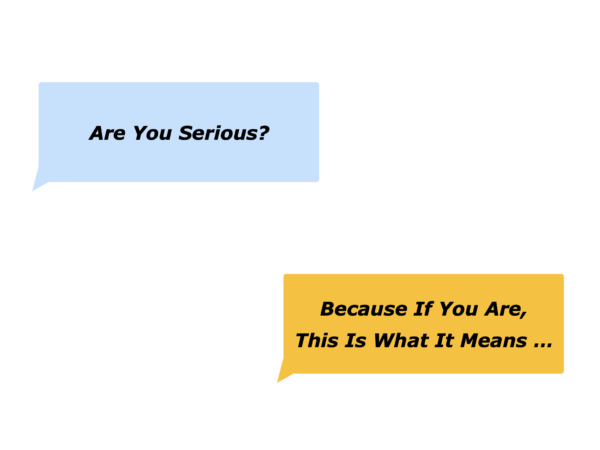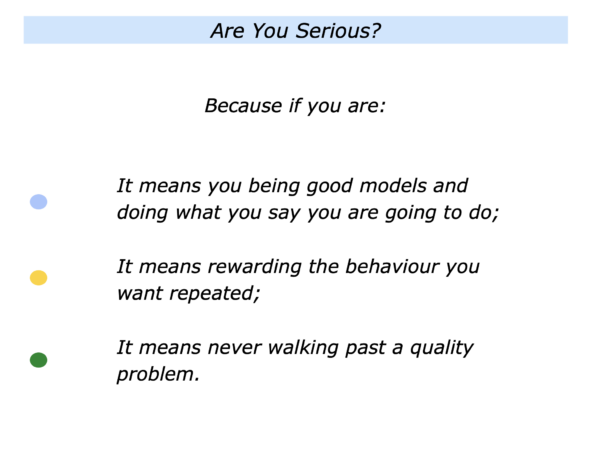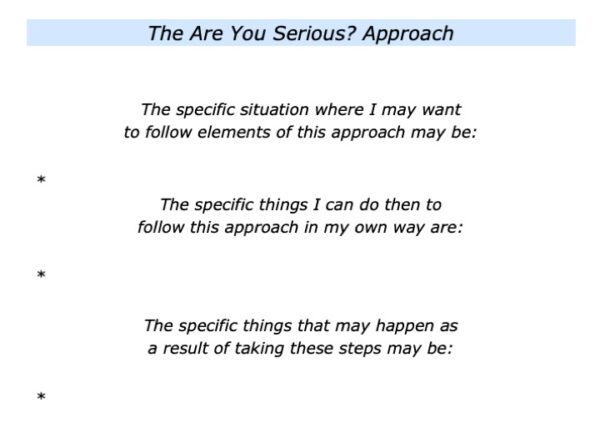
This is an approach that can be used by individuals, teams or organisations. It can be particularly useful when deciding whether or not to follow a particular strategy. When doing so, it can be useful:
To clarify the specific strategy that people say they want to follow;
To clarify the pluses and minuses of following the strategy;
To clarify whether they are really serious and prepared to accept the pluses and minuses of following the strategy.
This is an approach I often used I used with leadership teams towards the end of values workshops. Let’s consider one example.
The leadership team I was working with had clarified the values they believed it would be important for people in the company to follow in the future. These were:
Take Responsibility … Encourage People … Deliver Results … Keep Developing
The team planned to introduce these values to their people in the following ways.
By aiming to live their values themselves;
By sharing successes stories of when people in the company had lived the values in the past;
By involving their people in sessions where they could share ideas about how the values could be lived;
By producing some quick wins that showed they would translate the values into action;
By giving people the support they needed to live the values and deliver success.
The leadership team was all set to press the button. Before they went ahead, however, I asked them to consider the following themes.
First: To explore the pluses
and minuses of living the values
It was important to clarify the pluses and minuses of living the values: a) for the company – including themselves as a leadership team; b) for the customers; c) for the colleagues; d) for any other stakeholders.
Second: To explore if they were
really serious about living the values
This called for inviting the leadership team members to explore the following themes.
“Bearing in mind the pluses and minuses involved, are you really serious?
“Do you really want to aim to live the values? Because if you are, these are the implications …
“For example, it means you: Aiming to be good models; Rewarding the behaviour you want repeated; Never walking past a quality problem.
“Bearing these things in mind, on a scale 0-10 how serious are you about aiming to really live the values?”

The leadership team explored all these themes. They did this in the following way.
They began by focusing on their own behaviour. They listed the Dos and Don’ts they needed to bear in mind – both as individuals and as a whole team – to translate the values into action.
They then explore how to encourage people to live the values. This included having a mission holder who to responsibility for finding and publicising success stories about how people in the company were living the values.
They finally focused on making tough decisions. This included never walking past a quality problem – whether this was poor service quality or people behaving in an unprofessional way – because this would be saying that such behaviour was okay.
The leadership team looked at how to offer people positive alternatives in such situations. They needed to be able to show people:
The professional standards that could be followed to do such things in the future;
The benefits of following these professional standards;
The leaders needed to give individuals the opportunity of decide if they wanted to follow the professional standards. Sometimes a person may need help to follow these standards in their own way.
If a person chose to continuing behaving in an unprofessional way, however, this would call for making a tough decision. It would mean hiring somebody who wanted to deliver the required professional standards.
The leadership team explored how they could aim: a) to build on the positive aspects of living the values; b) to manage any of the potential minuses. The latter called for rehearsing how to deal with several challenging scenarios.
The leadership team then rated their seriousness in terms of living the values. Bearing in mind the pluses and minuses involved, they rated their seriousness as 8+/10.
A postscript. I worked with this company for the next five years. During this time the feedback from the employees was that the leaders and most people in the company did live the values.
Individuals Can Also Ask
Themselves: Am I Serious?
The Are You Serious? approach is one that is sometimes used by individuals. Such a person may aim:
To clarify the goal they want to achieve – the picture of success;
To clarify the strategies they can follow to achieve the picture of success;
To clarify the pluses and minuses involved in working towards achieving their picture of success.
Such an individual does their due diligence. After exploring the work involved, they may then ask themselves the following questions.
“Bearing in mind the pluses and minuses involved, how serious am I about doing what is required to reach the goals? Rate this on a scale 0-10.”
Such a person makes sure the rating is at least 8+/10. They then commit themselves to doing their best to achieve the specific goal.
Let’s return to your own life and work. Looking ahead, can you think of a situation where you may use elements of this approach?
You may aim to do it when helping a team to live their values, clarify their future strategy or take other steps. You may do it when helping a person to decide if they want to work towards achieving a specific goal.
If you wish, try tackling the exercise on this theme. This invites you to complete the following sentences.







Leave a Reply